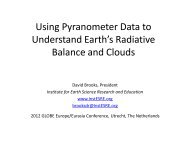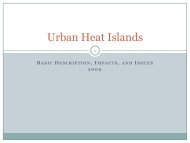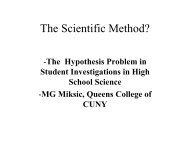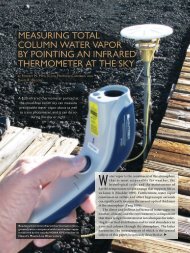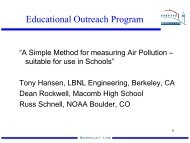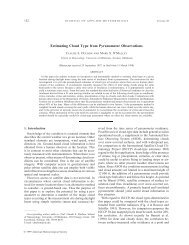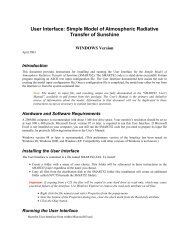Workshop to Define Student Collaborative Climate Research
Workshop to Define Student Collaborative Climate Research
Workshop to Define Student Collaborative Climate Research
Create successful ePaper yourself
Turn your PDF publications into a flip-book with our unique Google optimized e-Paper software.
Projects involving climate observations are very difficult <strong>to</strong> start and maintain in any fashion that adds useful data <strong>to</strong> the understanding of<br />
long term climate change. The main barrier here is time, followed closely by instrument accuracy.<br />
However, there are a variety of smaller scale studies that can tell an interesting s<strong>to</strong>ry about climate processes with<br />
relatively low cost instruments:<br />
1. Urban heat island - your example below is quite feasible as long as temperature observations take place in a comparable manner at<br />
individual locations. For example some schools are part of school-based obs networks, but the instruments are clamped on <strong>to</strong> the roof or<br />
some similarly inappropriate locations. If they are all like that, fine, but the problem comes with inconsistency of siting across a network ...<br />
the results would not be spatially comparable. You might be better off driving along the main axes of a <strong>to</strong>wn with a car with a good<br />
temperature output, rather than use an inconsistent observation network.<br />
2. Land use/land cover and climate - transects of climate measurements can be designed on a very local scale <strong>to</strong> go across eco<strong>to</strong>nes<br />
where there is a transition from one ecosystem <strong>to</strong> another, or smaller field scale changes where you go from one land cover <strong>to</strong> another.<br />
Fairly low cost instruments can be deployed with the cooperation of the land owner(s); for instance, HOBO temperature instruments, and<br />
still allow sufficient accuracy <strong>to</strong> see the potential impacts of land cover change on temperature, or can be tied in <strong>to</strong> vegetation gradients.<br />
Land cover change can lead <strong>to</strong> climate change on a local basis. A simple 2-point study would compare the diurnal temperature cycle over<br />
an irrigated lawn versus over a non-irrigated lawn ... might be able <strong>to</strong> get cooperation from a local golf course. Finally, transect near water<br />
bodies might also be interesting <strong>to</strong> characterize.<br />
3. Topographic gradients - like (2), except temperature and precipitation differences across stations located at different elevations and on<br />
slope facets facing in a variety of directions.<br />
4. <strong>Climate</strong> station representativeness - with the cooperation of a climate station observer and the owner of the land where it is situated, set<br />
up low cost instruments both at the site and at random locations around the station <strong>to</strong> see how representative its measurements are of the<br />
local environment. In situ measurements are made at a point and some points may be better than others in representing the overall climate<br />
conditions of an area.<br />
Studies based on measurements usually come down <strong>to</strong> spatial gradients in climate, if one does not have many years for a study. The main<br />
point is <strong>to</strong> be consistent in the way one measures, quality of site, exposure of instruments, etc. Other student studies based on using<br />
his<strong>to</strong>rical climate observations taken by others, or on using simple <strong>to</strong> complex climate models are also available, if the student has an<br />
aptitude for and access <strong>to</strong> good computers. I do not know if anyone plays around with physical models of climate (like terrariums subject <strong>to</strong><br />
changing radiation levels, moisture availability, etc.), but I guess that is more of a demonstration of processes rather than an actual science<br />
experiment. That would be fun for looking at aspects of geoengineering.<br />
Michael A. Palecki, Science Project Manager, U.S. <strong>Climate</strong> Reference Network, NCDC, Asheville, NC (email, 11/11/2010





